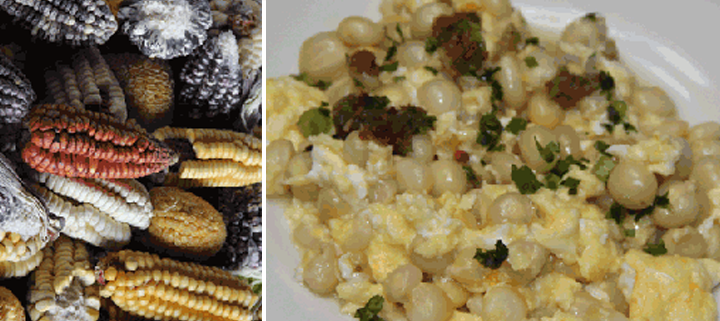Recipes from
Ecuador
My
right hand helper in Cuenca was Sofia. Not only was she the
assistant to my friend Carlos (and his right hand, too) but her family
owned the hotel in the city where I stayed. So, I saw
Sofia a lot.
When I designed the mural, I worked on it hours into the night and skipped supper. Upon completion, Sofia was the first to see the sketch. She loved it and then asked if I wanted food. I loved that about her.
The plate of lasagna that I was given was the absolute best pasta I ever had! I had to get the recipe. Alas! It was made by a friend who ran a catering business. No amount of begging could get me the recipe. Believe me, I begged.
Since corn is one of the Western Hemisphere's gifts to the world, I thought a recipe with corn might be an interesting choice from Ecuador. Although the specific origin of corn is disputed (probably Mexico), it was a staple of the Incas, Mayas, Aztecs, and Native Americans as far north as South Dakota. The people at my hotel suggested the perfect corn dish, mote pillo. However, corn in Ecuador doesn't look anything like the yellow sweet corn I know back home. It looks much closer to white hominy on the cob. And, this is a recipe with white hominy.
I sought out mote pillo at one of my favorite restaurants, Raymipampa, right on the center square in Cuenca. It was part of the dishes included in the "plato típico". The Ecuadorian typical plate included fried pork and a black sausage called morcilla. My recommendation is to skip the sausage. I took one bite and just couldn't do it. Salad consisted of lettuce, carrots, peas, onions, and a wonderful slice of avacado. Then, came the really good stuff - llapingacho (the potato patty I discovered in the Galapagos Islands) and the mote pillo.
If you've ever had hominy, you know it has kind of an unusual texture in your mouth. These eggs and hominy were no exception. When I was a kid, we always ate hominy with ketchup. (I really don't know if anyone else ever does that.) So, when I ate my mote pillo, I had an irresistible urge to reach for the ketchup. There was none. In Ecuador you always use a hot sauce called aji.

In Ecuador, mote (or white corn) comes dried and in bags like I'm used to buying dried beans at the store. If you can find them, use that. If not, it's hominy time.
Combine the diced onion, garlic, salt, butter, and color oil. Okay, I don't have colored oil, but it exists in Ecuador. It is oil that is spiced with "achiote", which to the best of my guessing is some kind of hot pepper. So, if you want to make your own, blend some oil with red pepper seeds (or go to Ecuador and get some color oil.) Fry this all up together.
Toss in the eggs, stir everything together, add the milk, and the mote until all ingredients are combined. Stir continuously over low heat. You're making some kind of scrambled eggs, so it shouldn't be too hard to judge when it is done.
Garnish with a sprinkling of chopped shallots.
I read, and was told repeatedly, that "cuy" was a local favorite. I looked for it at the market place either cooked or cuddly. I never found any. It's just as well. I don't eat cuddly, and I certainly have no desire to eat guinea pig. However, just to be thorough, I found out how to cook the critter.
To prepare the dressing and marinade in the blender, combine the garlic, cumin, celery, green pepper, salt, parsley, and cilantro. Blend until you have a paste of tasty ingredients.
Place your guinea pig in a roasting pan and thoroughly soak and smear it with that paste. To add some color to your little pig, brush on some of that elusive color oil with a small brush. No color oil in your kitchen? Go to Ecuador or perhaps try blending oil and red pepper seeds. Then place it in the oven over medium heat, covered with foil, until it is golden.
When I asked how long and exactly what temperature to cook the cuy, I was told you really should cook it over coals in a barbecue. That didn't answer my question. But, I'm going to assume it's like baking a chicken, so cook your little creature at 375 F. for around 20 minutes per pound of meat.
Now, how do you serve the critter? Line a plate with lettuce and place a few pealed boiled potatoes in the center. You need to cover the potatoes with a special peanut sauce.
If guinea pig doesn't float your boat, like me, you could always substitute a chicken.
When I designed the mural, I worked on it hours into the night and skipped supper. Upon completion, Sofia was the first to see the sketch. She loved it and then asked if I wanted food. I loved that about her.
The plate of lasagna that I was given was the absolute best pasta I ever had! I had to get the recipe. Alas! It was made by a friend who ran a catering business. No amount of begging could get me the recipe. Believe me, I begged.
Since corn is one of the Western Hemisphere's gifts to the world, I thought a recipe with corn might be an interesting choice from Ecuador. Although the specific origin of corn is disputed (probably Mexico), it was a staple of the Incas, Mayas, Aztecs, and Native Americans as far north as South Dakota. The people at my hotel suggested the perfect corn dish, mote pillo. However, corn in Ecuador doesn't look anything like the yellow sweet corn I know back home. It looks much closer to white hominy on the cob. And, this is a recipe with white hominy.
I sought out mote pillo at one of my favorite restaurants, Raymipampa, right on the center square in Cuenca. It was part of the dishes included in the "plato típico". The Ecuadorian typical plate included fried pork and a black sausage called morcilla. My recommendation is to skip the sausage. I took one bite and just couldn't do it. Salad consisted of lettuce, carrots, peas, onions, and a wonderful slice of avacado. Then, came the really good stuff - llapingacho (the potato patty I discovered in the Galapagos Islands) and the mote pillo.
If you've ever had hominy, you know it has kind of an unusual texture in your mouth. These eggs and hominy were no exception. When I was a kid, we always ate hominy with ketchup. (I really don't know if anyone else ever does that.) So, when I ate my mote pillo, I had an irresistible urge to reach for the ketchup. There was none. In Ecuador you always use a hot sauce called aji.
Mote
Pillo
my friends at Casa San Rafael and Casa Bravo
my friends at Casa San Rafael and Casa Bravo
Ecuador

|
1
can mote or mature corn
......(that's the
hominy)
1
white onion
a
pinch of garlic (in paste)
salt
to taste
|
1
Tbs butter or oil 1 Tbs of color oil 1 cup of milk 2 eggs shallots |
In Ecuador, mote (or white corn) comes dried and in bags like I'm used to buying dried beans at the store. If you can find them, use that. If not, it's hominy time.
Combine the diced onion, garlic, salt, butter, and color oil. Okay, I don't have colored oil, but it exists in Ecuador. It is oil that is spiced with "achiote", which to the best of my guessing is some kind of hot pepper. So, if you want to make your own, blend some oil with red pepper seeds (or go to Ecuador and get some color oil.) Fry this all up together.
Toss in the eggs, stir everything together, add the milk, and the mote until all ingredients are combined. Stir continuously over low heat. You're making some kind of scrambled eggs, so it shouldn't be too hard to judge when it is done.
Garnish with a sprinkling of chopped shallots.
I read, and was told repeatedly, that "cuy" was a local favorite. I looked for it at the market place either cooked or cuddly. I never found any. It's just as well. I don't eat cuddly, and I certainly have no desire to eat guinea pig. However, just to be thorough, I found out how to cook the critter.
Cuy
(Yes, Guinea Pig)
my friends at Casa San Rafael and Casa Bravo
my friends at Casa San Rafael and Casa Bravo
Ecuador
|
1
guinea pig
2
Tbs garlic
1
onion, chopped
dash
of cumin
1
celery stick
1
green pepper
|
salt
to taste 1 spring of parsley 1 sprig of cilantro brush of colored oil 1/2 cup of oil |
To prepare the dressing and marinade in the blender, combine the garlic, cumin, celery, green pepper, salt, parsley, and cilantro. Blend until you have a paste of tasty ingredients.
Place your guinea pig in a roasting pan and thoroughly soak and smear it with that paste. To add some color to your little pig, brush on some of that elusive color oil with a small brush. No color oil in your kitchen? Go to Ecuador or perhaps try blending oil and red pepper seeds. Then place it in the oven over medium heat, covered with foil, until it is golden.
When I asked how long and exactly what temperature to cook the cuy, I was told you really should cook it over coals in a barbecue. That didn't answer my question. But, I'm going to assume it's like baking a chicken, so cook your little creature at 375 F. for around 20 minutes per pound of meat.
Now, how do you serve the critter? Line a plate with lettuce and place a few pealed boiled potatoes in the center. You need to cover the potatoes with a special peanut sauce.
|
1/2
cup
roasted peanuts
1
cup of milk
|
dash
of cumin dash of pepper |
When
the recipe was explained to me, you take raw peanuts and roast them
on an open skillet. No oil. Just roast those little nuts
until the skin parches and the nuts turn color a bit. (Or, if
you are like me, buy some roasted peanuts.) Toss the nuts in a
blender and mix up the milk, pepper, and cumin. Finally, heat
it up and then pour over the potatoes. Think you're
done? No, now you set the whole guinea pig on top of the
potatoes.
If guinea pig doesn't float your boat, like me, you could always substitute a chicken.
